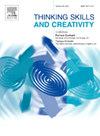Development of a digital Creative Figural Design Test (CFDT): An approach to integrating divergent and convergent processes
IF 3.7
2区 教育学
Q1 Social Sciences
引用次数: 0
Abstract
Traditional design fluency tests assess an individual's fluency in figural thinking. This fluency is considered a component of executive function, but is also an indicator of divergent thinking in creative thinking tests. However, few studies have examined the creative potential in design fluency tests. In addition, traditional tests are typically administered using pen and paper, making scoring relatively cumbersome and time-consuming; and, other indicators of divergent thinking (such as flexibility and originality) can be developed in traditional tests. Therefore, this study aims to develop a digital Creative Figural Design Test (CFDT) and use digital scoring methods to explore the creative processes and potential within design fluency tests. In phase one, the CFDT was developed, establishing norms for design fluency, design flexibility, and design originality based on 428 participants’ responses to 200 correct designs. Design flexibility was classified into nine categories through the feature detection rules. For design originality, participants’ responses to the 200 correct designs were scored based on frequency. In phase two, digital scoring of the CFDT was established, allowing for instant calculation of three indicators and comparison with norms. 143 participants were invited to finish the CFDT and validity tests (including divergent thinking test and remote associates test). Reliability analysis showed an acceptable test-retest reliability for three indicators. Validity analysis indicated that the design fluency was positively correlated with the two creative tests, while design flexibility and design originality were only correlated with divergent thinking. We have developed a new open-source tool that further understands the relationship between executive function and creativity.
求助全文
约1分钟内获得全文
求助全文
来源期刊

Thinking Skills and Creativity
EDUCATION & EDUCATIONAL RESEARCH-
CiteScore
6.40
自引率
16.20%
发文量
172
审稿时长
76 days
期刊介绍:
Thinking Skills and Creativity is a new journal providing a peer-reviewed forum for communication and debate for the community of researchers interested in teaching for thinking and creativity. Papers may represent a variety of theoretical perspectives and methodological approaches and may relate to any age level in a diversity of settings: formal and informal, education and work-based.
 求助内容:
求助内容: 应助结果提醒方式:
应助结果提醒方式:


